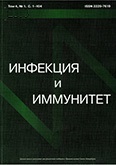INTERACTIONS OF PATHOGENIC BACTERIA WITH INNATE IMMUNE REACTIONS OF HOST
- Authors: Garib F.Y.1, Rizopulu A.P.1
-
Affiliations:
- ГОУ ДПО Российская медицинская академия последипломного образования, Москва
- Issue: Vol 2, No 3 (2012)
- Pages: 581-596
- Section: LECTURES
- Submitted: 02.07.2014
- Accepted: 02.07.2014
- Published: 02.07.2014
- URL: https://iimmun.ru/iimm/article/view/74
- DOI: https://doi.org/10.15789/2220-7619-2012-3-581-596
- ID: 74
Cite item
Full Text
Abstract
Abstract. «Efficacy» of pathogens interaction with the immunity system is manifested by broad spreading of many bacterial infections including tuberculosis first of all and in activation of known and emergent pathogens. The refined mechanisms of avoiding of bacteria from recognizing by immune system as creation of obstacles for phagocytosis and intracellular killing, using of secretory systems like “syringe” for inoculation into host cells deregulated substances, suppression or enhancing of inflammatory response, activation of inhibitory receptors to suppress respiratory explosion in phagosome, decreasing of synthesis of proinflammatory cytokines by influences to inflammasomes, stimulation of cytokines production suppres sed of innate response, damage of key molecules on intracellular signal routes, manipulation with apoptosis and auto phagia with the aim of surviving and replication inside the host cells, blocking of processing and presentation of bacterial antigens have been evolutionary developed. The study of interaction between host and parasite allows to understand new facts characterized “logic of live being” on the pathogen level and to use their mechanisms of evasion for resolving of actual problems raised in human society, for example, development of original vaccines and principally new drugs for immune system correction in case of diseases such as oncogenic tumors, autoimmune and allergic diseases as well as infectious diseases which are difficult to prevent and treat. Moreover, it was proved that permanent interaction with microorganisms including pathogenic ones is useful for human being because bacterial substances “train” immune system of people and assist its evolutionary improvement.
About the authors
F. Yu. Garib
ГОУ ДПО Российская медицинская академия последипломного образования, Москва
Author for correspondence.
Email: fgarib@yandex.ru
д.м.н., профессор, профессор кафедры иммунологии
119421, Москва, ул. Обручева, 24-121
РоссияA. P. Rizopulu
ГОУ ДПО Российская медицинская академия последипломного образования, Москва
Email: fgarib@yandex.ru
Россия
References
- Хаитов Р.М. Иммунология: учебник. — М.: ГЭОТАР-Медиа, 2011. — 520 с.
- Ярилин А.А. Иммунология: учебник. — М.: ГЭОТАР-Медиа, 2010. — 752 с.
- Bacterial evasion of host immune responses / Еds. B. Hen derson, P.C.F. Oyston / Cambrige university press, 2003. — 304 p.
- Belkaud Y., Tarbell K. Regulatory T-cells in the control of host-microorganism interactions // Annu. Rev. Immunol. — 2009. — Vol. 27. — P. 551–589.
- Bowie A.G., Unterholzner L. Viral evasion and subversion of pattern-recognition receptor signalling // Nat. Rev. Immunol. — 2008. — Vol. 8. — P. 911–922.
- Brodsky I.E., Medzhitov R. Targeting of immune signalling networks by bacterial pathogens // Nat. Cell Biol. — 2009. —Vol. 11. — P. 521–526.
- Coburn B., Sekirov I., Finlay B.B. Type III secretion systems and disease // Clin. Microbiol. Rev. — 2007. — Vol. 20, N 4. — P. 535–549.
- Coombes B.K., Valdez Y., Finlay B.B. Evasive maneuvers by secreted bacterial proteins to avoid innate immune responses // Curr. Biol. — 2004. — Vol. 14. — P. R856–R867.
- Diacovich L., Gorvel J. P. Bacterial manipulation of innate immunity to promote infection // Nat. Rev. Microbiol. — 2010. — Vol. 8. — P. 117–128.
- Evasion and subversion of innune defenses / Janeway’s Immunobiology. — 7th ed. — N.Y.–London: Garland Science, 2008. — P. 498–507.
- Finlay B.B., McFadden G. Anti-immunology: evasion of the host immune system by bacterial аnd antiviral pathogens // Cell. — 2006. — Vol. 124. — P. 767–782.
- Flannagan R.S., Cosio G., Grinstein S. Antimicrobial mechanisms of phagocytes and bacterial evasion strategies // Nat. Rev. Microbiol. — 2009. — Vol. 7. — P. 355–366.
- Hajishengallis G., Lambris J.D. Microbial manipulation of receptor crosstalk in innate immunity // Nat. Rev. Immunol. — 2011. — Vol. 11. — P. 187–194.
- Kaufmann S.H.E., Collihs H.L., Schaible U.E. Immune response to intratracellular bacteria // Clinical immunology — principals and practice. — Mosby, Elsevier, 2008. — 3d ed. — P. 389–409.
- Kaufmann S.H.E., Schaible U.E. Antigen presentation and recognition in bacterial infections // Curr. Opin. Immunol. — 2005. — Vol. 17. — P. 79–87.
- Kopp E., Medzhitov R. A plague on host defense // J. Exp. Med. — 2002. — Vol. 196, N 8. — P. 1009–1012.
- Lambris J.D., Ricklin D., Geisbrecht B.V. Complement evasion by human pathogens // Nat. Rev. Microbiol. — 2008. — Vol. 6. — P. 132–142.
- Ly K.T., Casanova J.E. Mechanisms of Salmonella entry into host cells // Cell. Microbiol. — 2007. — Vol. 9, N 9. — P. 2103–2111.
- Medzhitov R. The innate immune system // Fundamental Immunology / Ed. W.E. Paul. — 6th ed. — Lippincott Williams&Wilkins, 2008. — P. 427–450.
- Pathogen-derived immunomodulatory molecules // Adv. Exp. Med. Biol. / Ed. P.G. Fallon. — 2009. — Vol. 666. — 183 p.
- Sansonetti P.J., Di Santo J.P. Debugging how bacteria manipulate the immune response // Immunity. — 2007. — Vol. 26. — P. 149–161.
- Steevels T.A., Meyaard L. Immune inhibitory receptors: essential regulators of phagocyte function // Eur. J. Immunol. — 2011. — Vol. 41, N 3. — P. 575–587.
- Stephens D.S., Shafer W.M. Immune response to extracellular bacteria // Clinical immunology — principals and practice. — Mosby, Elsevier, 2008. — 3d ed. — P. 377–388.
- Taxman D.J., Huang M.T., Ting J.P. Inflammasome inhibition as a pathogenic stealth mechanism // Cell Host Microbe. — 2010. — Vol. 8, N 1. — P. 7–11.
- The immune response to infection // Eds. Kaufmann S.H.E., Rouse B.T., Sacks D.L. — Washington DC: ASM Press, 2011. — 666 p.
Supplementary files







